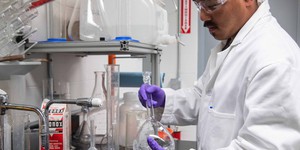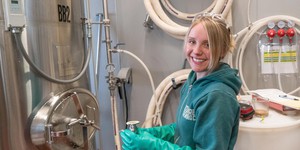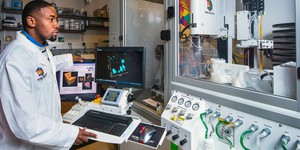Abstract
Have you ever looked in the kitchen cupboard and found a container of tiny white grains, but you were not sure if they were sugar or salt? They look very similar. How could you tell them apart? Well, you know that sugar and salt taste very different. Taste is actually called a property, and properties are used to describe and identify different materials. Properties can also be used to physically separate things. In this science project, you will use different properties to create a way to separate a mixture of three different materials: salt, sand, and iron filings.Summary
Teisha Rowland, PhD, Science Buddies

Objective
Figure out a way to separate a mixture of salt, sand, and iron filings, based on the materials' different properties.Introduction
Salt and sugar look very similar; they are both tiny, white grains. But you can easily tell them apart because they taste very different. Taste is what is called a property of matter. Everything you see around you is matter. A property of matter is basically a way we can describe matter, and how we can say it is different from other matter. For example, size and color are both properties of matter, and we can use them to say that both salt and sugar are tiny, white grains. This is how they are similar. We can use a different property—the property of taste—to describe how sugar and salt are different; sugar tastes sweet, while salt is salty!
Not only can we use properties of matter to describe something, but we can also use them to separate something from a mixture. Scientists do this in laboratories all the time when they have a mixture, but only want to study one part of that mixture. What are some important properties to use if you want to separate different parts of a mixture?
While you are probably familiar with describing things based on their size, color, and taste, another useful property that you might be less familiar with has to do with magnets. A magnet creates an invisible magnetic field around it. Some types of matter are not affected by this field, but other types of matter are. Specifically, magnetic fields can attract other materials that also have magnetic properties. For example, you have probably seen a magnet stick onto a refrigerator door. This is usually because the door is made out of metal. Many different types of metals, such as iron, are affected by magnets and can be pulled toward them, as shown in Figure 1, below.
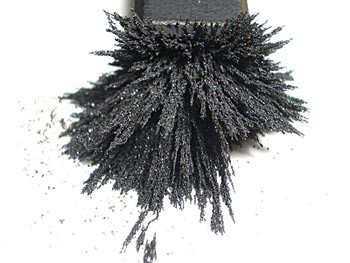 Image Credit: Wikimedia Commons / Creative Commons Attribution-Share Alike 3.0 Unported
Image Credit: Wikimedia Commons / Creative Commons Attribution-Share Alike 3.0 Unported
Figure 1. Magnets pull some types of matter toward them. For example, the magnet at the top of this picture is pulling lots of powdered steel toward it. Steel has iron in it, which is magnetic.
If you want to separate a mixture, another important property of matter that can be used is solubility (pronounced sol-you-BIH-luh-tee). We think about solubility when we dissolve something in water. If a matter is soluble in water, then that matter will dissolve, or disappear, when you add it to water. For example, think of how sugar dissolves in hot water for tea or in a hot cup of coffee. Sugar is soluble in water. If something is not soluble, or insoluble, then it will not dissolve and you will still see it floating around in the water or at the bottom of the container. For example, imagine dropping a hard piece of gravel in a stream; it sinks to the bottom, but does not dissolve in the water. So, a piece of gravel is insoluble in water. This means that you could have a mixture of sugar (soluble in water), and gravel (insoluble in water), and then mix them with water (hot water works best for dissolving things) and the sugar would disappear into the water while the gravel would be visibly left behind. But even though the soluble material would become invisible, it is still actually there. If you were to dissolve something in water and then evaporate all of the liquid away, you would be left with your dry, soluble piece of matter (sugar in this example) again.
Lastly, scientists also often use density, which is another property of matter, when they are trying to separate a mixture. Technically, density is the mass, or weight, of an object divided by its volume. This basically means that if you have two rocks that are the same size, but one is much heavier than the other, the heavier rock has a greater density, or is denser, than the lighter rock. Scientists often use a machine called a centrifuge to separate different materials based on differences in their densities. In a centrifuge, tubes are filled with some kind of mixture, and then the centrifuge basically spins those tubes really fast. When it is done spinning, the different parts of the mixture should be separated based on their densities, with the densest parts at the bottom of the tube and the less-dense parts higher up in the tube.
In this science project, you will design and test a way to separate a mixture of salt, sand, and iron filings, based on different properties of matter. See Table 1 in the Experimental Procedure for information on these different types of matter and how they may be able to be separated based on how they respond to magnets, their solubility in water, and their density. You will be shown a way to make a device to separate iron filings from sand, using magnets. You can add to that device, or make a new device (or multiple devices) to come up with a complete protocol, or procedure, to separate the mixture of salt, sand, and iron filings.
You will determine how well your method works based on the yield and purity of your results. Yield is how much of something you end up with. For example, if you have a mixture of salt, sand, and iron filings, and there is 1 cup (C) of each in the mixture, and you are able to separate out ½ C of the iron filings, your yield for the iron filings would be ½ C. You could also calculate the percent yield, which lets you see how much you ended up with relative to how much you started with. For example, the percent yield of iron filings would be 50% in this example (since you started with 1 C and ended up with ½ C, and ½ C is 50% of 1 C). The higher the yield you get, the better your protocol worked! Purity is how pure your result is; in other words, whether you have contamination of things that you did not want. For example, if you wanted to separate iron filings from salt, but ended up with some salt in your iron filings, the salt would be contamination. If you have a lot of contaminating salt, then the iron filings are not very pure, but if you have only a little bit of contaminating salt, then the iron filings may be very pure. The purer your results, the better your protocol worked!
This is a rather open-ended science project, with many possible solutions and opportunities for creative exploration. So get ready to design some devices and methods that will separate your mixture!
Terms and Concepts
- Matter
- Property of matter
- Magnet
- Solubility
- Soluble
- Dissolve
- Insoluble
- Density
- Centrifuge
- Protocol
- Yield
- Purity
Questions
- How do you think you could separate iron filings that are mixed together with sand?
- What are some materials that are attracted to magnets?
- How could you separate a mixture of two things if one is soluble in water and the other is not?
- What is density?
- What machine can be used to separate things based on their density?
Bibliography
You can do further research by visiting the following websites, which give information about matter, magnets, solubility, and centrifuges:
- Rader, A. (n.d.). Matter. Rader's Chem4kids.com. Retrieved August 13, 2013.
- Rader, A. (n.d.). What is a Magnet? Rader's Physics4kids.com. Retrieved August 13, 2013.
- Kids.Net.Au. (n.d.). Solubility. Retrieved August 13, 2013.
- Wood, C. (2012, September 20). Centrifuges. Explain That Stuff. Retrieved August 13, 2013.
For help creating graphs, try this website:
- National Center for Education Statistics, (n.d.). Create a Graph. Retrieved June 25, 2020.
Materials and Equipment
- Sand (about 2 ½ C for testing 5 protocols); available at arts and crafts stores. If you think you will test more than 5 protocols, you may want to have more sand available.
- Iron filings (12 oz. should be sufficient for testing about 5 protocols). Iron filings are available from science supply stores or online at Amazon.com. If you think you will test more than 5 protocols, you may want to order additional jars of iron filings.
- Table salt (about 1 ½ C). If you think you will test more than 5 protocols, you may want to have more salt available.
- Measuring spoon
- Measuring cup
- Large jar or other container that has a tight-sealing lid
- Piece of paper or wax paper
- Scissors
- Digital scale. A digital scale (the Fast Weigh MS-500-BLK Digital Pocket Scale) is available from Amazon.com.
- Lab notebook
Here is a list of things that, if gathered, may be useful in your science project, but it depends on how you design your device(s) and protocol:
- Clear plastic water or soda bottle
- Knife
- Shipping tape
- Neodymium magnet discs, ½ inch by 1/16 inch (8–10). Neodymium magnet discs are available from science supply stores like K&J Magnetics or online at Amazon.com. Important: Large neodymium magnets are very strong. You need to use small magnets (less than or equal to 1/2 inch diameter and 1/16 inches thick) for this project. The selection of magnets available from Amazon varies, so make sure you search for the right size.
- Glass jars (2). They should have an opening wide enough for the tip of the clear plastic water or soda bottle to fit in, but narrow enough that the whole bottle does not fall in. Baby food jars can be used, but they can not hold as much.
- Optional: Camera
- Coffee filter
- Funnel
- Stovetop and/or oven
- Teakettle or pot
- Glass canning jar that can withstand being safely heated in an oven
- Materials to build a homemade centrifuge, as described in the science project Separating Butter with a Salad Spinner Centrifuge
Disclaimer: Science Buddies participates in affiliate programs with Home Science Tools, Amazon.com, Carolina Biological, and Jameco Electronics. Proceeds from the affiliate programs help support Science Buddies, a 501(c)(3) public charity, and keep our resources free for everyone. Our top priority is student learning. If you have any comments (positive or negative) related to purchases you've made for science projects from recommendations on our site, please let us know. Write to us at scibuddy@sciencebuddies.org.
Experimental Procedure
Neodymium magnets are very strong. Adult supervision is recommended when using them. Do not let the magnets slam together. They may pinch your fingers or crack. Keep them away from small children, pets, credit cards, and pacemakers.
Building a Device and Protocol to Separate a Mixture of Sand, Iron Filings, and Salt
- Note: For convenience, this science project involves household measuring tools, so volumes are given in terms of United States customary units (such as cups and tablespoons). However, science is done in metric units, so you may need to convert when writing up your procedure. To convert units, you can use this metric conversions & US customary unit conversion calculator.
- Part of this science project follows the Engineering Process. To learn more about the Engineering Process, and how it is different from the science projects that follow the Scientific Method, see this Science Buddies resource Comparing the Engineering Design Process and the Scientific Method.
- For this science project, you are expected to design a way to separate a mixture of sand, table salt, and iron filings. Steps are given to guide you through building a way to separate sand and iron filings, and then suggestions are given to help guide you through separating a mixture with all three components.
- You can find additional information about this process from Engineering Design Process resource.
- Table 1, below, is a summary of some of the key, different properties of iron filings, sand, and salt. Look at the table and think about how iron filings, sand, and salt are different from each other, and how are they similar. Think about how you could use their differences to separate them. Also think about how they might be too similar in some ways to separate them.
| Iron Filings | Sand | Table Salt | |
|---|---|---|---|
| Attracted to magnets? | Yes | No | No |
| Soluble in water? | No | No | Yes |
| Density (in g/cm3) | 7.86 | 2.65 | 2.17 |
- You will first investigate a way to separate iron filings from sand. How do you think this could be done? For this initial test, you will focus on the yield and purity of the iron filings that you separate from this mixture. Make a data table in your lab notebook like Table 2, below, to record your results in for this initial test.
| Initial Weight (in grams) | Yield (in grams) |
Percent Yield | Purity | |
|---|---|---|---|---|
| Iron Filings |
- Make a mixture of iron filings and sand. For this initial test, we recommended you try using 1 C of sand and 1 Tablespoon (Tbsp.) of iron filings. You will also weigh the iron filings so you can later determine your yield.
- Measure and pour 1 C of sand into a large jar or other container that has a tight-sealing lid.
- Measure 1 Tbsp. of iron filings, but do not add it to the jar yet.
- Weigh the 1 Tbsp. of iron filings.
- To weigh the iron filings, cut a small piece of paper or wax paper (around 8 centimeters [cm]–10 cm on each side), place the paper on the scale, zero out the scale (so that it reads "0 g"), and then carefully weigh the iron filings on the paper.
- Note: Some scales, such as the Fast Weigh MS-500-MLK Digital Pocket Scale, come with a small tray that you can use to weigh things, so you will not need to use a piece of paper.
- Tip: If the scale you are using does not have a feature to zero it out, you will need to first weigh the piece of paper so that you can subtract this weight from the total when you weigh the iron filings on it.
- To weigh the iron filings, cut a small piece of paper or wax paper (around 8 centimeters [cm]–10 cm on each side), place the paper on the scale, zero out the scale (so that it reads "0 g"), and then carefully weigh the iron filings on the paper.
- Once you have weighed the 1 Tbsp. of iron filings, record its weight (in grams) in the data table in your lab notebook. Then add the iron filings to the sand in the jar, which should now look like Figure 2, below.
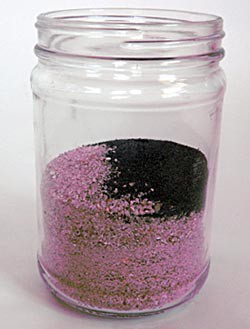
Figure 2. Add 1 C. of sand and 1 Tbsp. of iron filings to a glass jar.
- Put the lid tightly on the jar.
- Mix the iron filings and sand together by flipping the jar upside down and then right-side up again (this is called inverting the jar). Do this about ten times, or until the iron filings appear to be evenly dispersed throughout the sand in the jar, as shown in Figure 3, below.
- How easy is it to see the iron filings in the jar?
- How easy do you think it will be to separate the iron filings from the sand?
- Write any observations you make in your lab notebook.
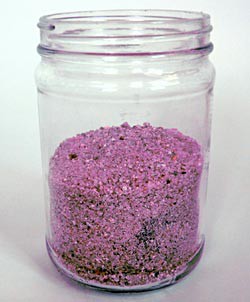 Image Credit: Teisha Rowland, Science Buddies / Science Buddies
Image Credit: Teisha Rowland, Science Buddies / Science Buddies
Figure 3. Put the lid on the jar and mix the sand and iron filings together by inverting the jar about ten times, or until the contents appear mixed.
- Your goal now is to create a way to separate the iron filings from the sand. Think about how you could do this. There are many possibilities.
- Look at Table 1 and think about how iron filings and sand are different from each other, and how they are similar. How could you use their differences to separate them?
- You will want to determine the yield and purity of your results. For examples of what yield and purity are, re-read the end of the Introduction.
- One way you could separate iron filings from sand is by making a funnel from the top of a plastic water bottle, taping magnets to the outside of the funnel, and pouring the mixture of iron filings and sand through the funnel. When this happens, the magnetic materials, like the iron filings, should get trapped on the magnets, while the other materials pass through the funnel.
- The video below contains specific instructions for how to make such a funnel and general tips for this science project.
- One way to do this science project is to start by re-creating the funnel in the video above and then continuing from there. Alternatively, you could skip making the funnel and try one of your own ideas.
- If you want to re-create the funnel in the video, continue on to step 11.
- If you want to try one of your own ideas, start working on it now. Steps 12–17, below, give some tips for designing, building, and testing a way to separate a mixture. Step 12 also gives information on how to determine the purity and yield of your results.
- If you want to make the device that is shown in the video, gather the required materials and try to make it by watching the video. You may want to re-watch the video a few times and/or pause it at certain points.
- You will need a clear plastic water or soda bottle, scissors, possibly a knife, shipping tape, neodymium magnet discs (8–10), and two jars with openings wide enough for the tip of the bottle to fit inside, but narrow enough for the tip of the bottle to rest in the openings.
- Important: You may need to have an adult help you cut the bottle in half. Also, be sure to follow all safety precautions when handling the neodymium magnets. These magnets should never slam together, never pinch fingers or skin, never be swallowed, and should be kept away from all electronic devices, as the magnets can destroy such devices. They should also be kept out of reach of young children and pets.
- When your device is complete, it should look similar to the one in Figure 4, below (as shown in the video).
- You will need a clear plastic water or soda bottle, scissors, possibly a knife, shipping tape, neodymium magnet discs (8–10), and two jars with openings wide enough for the tip of the bottle to fit inside, but narrow enough for the tip of the bottle to rest in the openings.
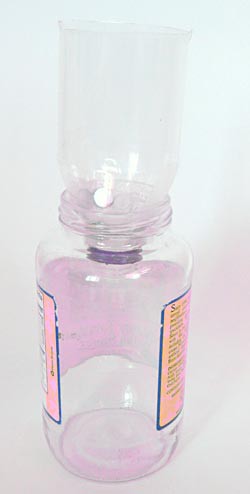 Image Credit: Teisha Rowland, Science Buddies / Science Buddies
Image Credit: Teisha Rowland, Science Buddies / Science Buddies
Figure 4. If you build a device like the one shown in the video, your device should end up looking similar to this one, with a funnel made out of an upside-down, cut water bottle and magnets taped to the bottom of the funnel, which should sit in the opening of a large jar.
- After you have made your device and/or protocol for separating the iron filings from the sand in the mixture, test it on your mixture. If you built a device like the one shown in the video, test the device as is shown in the video, paying attention to the following:
- When you pour the mixture through the bottle, do you see the iron filings sticking to the magnets?
- As shown in the video, slowly pour off any loose sand that is sitting on top of the iron filings in the bottle.
- When you have collected the iron filings in a separate jar, figure out the purity and yield of the iron filings.
- To figure out the purity, look at the iron filings in the jar. Is there much sand mixed in with the iron filings? In the data table in your lab notebook, record your observations, such as "mostly iron filings," "mostly sand," "very little sand," etc.
- To figure out the yield, weigh the iron filings that were collected in the jar. To do this, repeat step 5.c., above. Record the weight (in grams) in the data table in your lab notebook in the "Yield" column.
- Important: Neodymium magnets should be kept away from electronic devices. If you are using a digital scale, you should not put the magnets near the scale.
- Note: Keep in mind that, based on your purity observations, the yield may also include the weight of some contaminating sand.
- To calculate the percent yield, divide the "Yield" by the "Initial Weight." For example, if the initial weight was 48.5 g and the yield was 19.4 g, the yield would be 0.4, which is 40%.
- You should now have a device and/or protocol that separates sand from iron filings. Now think about how you can modify it (such as by making another device or adding steps to your protocol) to separate a mixture of sand, iron filings, and table salt. Look at Table 1, above, to get some ideas of how to do this. Remember that you will want to separate materials based on their differences from each other.
- Hint: Think about the properties of magnetism, solubility, and density. You may want to re-read the
Introduction to help you think about these properties. Here are some tips on using these different properties:
- Magnetism: You just used this property to separate sand from iron filings. You could use it again to pull the iron filings out from the mixture. You could use the same device you just built or make a new one using the principle of magnetism.
- Solubility: Remember that if something is soluble in water, this means that it will dissolve in water (hot water is usually best). Materials that are not soluble in water will not dissolve, and will stay separate from the water. Materials that do dissolve in water will stay in the water when the mixture is poured through something like a piece of coffee filter or paper towel. If the water is removed through evaporation, materials that were dissolved in the water should be left behind.
- Note: If you want to use an oven or stovetop, be sure to have an adult help you use it, and only use containers that can be safely used with an oven or stovetop.
- Density: One way to separate materials based on their densities is by using a centrifuge. See the Science Buddies science project Separating Butter with a Salad Spinner Centrifuge for information on how to make a homemade centrifuge and use it to separate materials based on their densities.
- Hint: You do not actually need to use all three of these properties to separate a mixture of sand, iron filings, and salt. You may be able to separate the mixture by just using two properties, such as magnetism and solubility.
- Hint: Think about the properties of magnetism, solubility, and density. You may want to re-read the
Introduction to help you think about these properties. Here are some tips on using these different properties:
- After you have thought of how to make a device and/or protocol to separate a mixture of sand, iron filings, and salt, plan how you will build it.
- You will probably want to sit down with a piece of blank paper and make some sketches. How will this device and protocol be different from what you used to separate iron filings from sand? How will it be similar, if it will be similar at all? Will you mostly use bottles, jars, and tape? What other materials will you need? How will you attach things together?
- You may want to come up with multiple ideas in case some of them do not work.
- Make sure to include a way to record your yield, percent yield, and make purity observations at the end.
- Tip: If you are using neodymium magnets again, it is recommended that you find a way to wrap them or block them from direct contact with the iron filings. (For example, you could separate them by using a plastic bottle in between, as you did before, or wrap them in plastic wrap.) This is because it is very difficult to remove iron filings from strong magnets!
- Important: Neodymium magnets should be kept away from electronic devices. This means if you are using a digital scale, you should not put the magnet near the scale.
- You will probably want to sit down with a piece of blank paper and make some sketches. How will this device and protocol be different from what you used to separate iron filings from sand? How will it be similar, if it will be similar at all? Will you mostly use bottles, jars, and tape? What other materials will you need? How will you attach things together?
- Build your device(s) or parts you will need to use in your protocol.
- If you encounter problems while building it, try to think of different approaches. For example, if different parts are not staying attached to each other, try different ways to attach them, such as by using a different kind of tape or rubber bands.
- You could try testing different parts as you build them, to make sure they are working as expected.
- If they do not work as expected, think of different approaches and try them out.
- You may want to ask an adult for help if you get stuck.
- Test your device(s) and/or protocol on a mixture of sand, salt, and iron filings. How well does it work?
- In your lab notebook, make a data table like Table 3, below. Record your testing results in the data table.
- You could try creating and testing a mixture of sand, salt, and iron filings that has ¼ C of each.
- Do not forget to record the initial weight of the iron filings, sand, and salt (separately) in your data table so that you can later determine your percent yield.
- When you are done testing, determine your yield, percent yield, and purity for the iron filings, sand, and salt (each separately).
- Tip: See step 12.c., above, for how to do this.
- You may also want to take pictures of your device(s) and different steps in your protocol, as well as your results, to later include on your Science Fair Project Display Board.
- If the first test run did not work well, do not get frustrated! Try to think about how you can improve your device(s) and/or protocol so that it does work. Think about the parts that did not work as you expected them to, and what you could try changing so that they work better.
- In a moment, we will discuss what to do if you want to improve your yields and purities.
| Initial Weight (in grams) | Yield (in grams) |
Percent Yield | Purity | |
|---|---|---|---|---|
| Iron Filings | ||||
| Sand | ||||
| Table Salt |
- Often, when we build something, it does not work exactly as expected the first time we test it. This is why in The Engineering Design Process, the importance of testing and redesigning something is stressed. Now that you have tested your device(s) and/or protocol, think about how you could make it work better. For example, how could you improve your yield and/or purity? Spend some time thinking about this, possibly redesign some parts, and then test it again.
- For example, think about in steps 9 and 10 when you built and tested a device to separate iron filings from sand. How could you have improved the yield and/or purity of your results when using that device?
- To improve the yield of iron filings you collected, you could have taken the jar that held the original mixture (that was mostly sand) and poured it through the bottle (with magnets attached) a few more times (into a new jar). Then removed the magnet strip to release the iron filings into your iron filings collection jar. This would help increase your yield, but it may decrease your purity.
- To improve the purity, you could have taken the jar that held the collected iron filings and poured it through the bottle (with magnets attached) a few times (into a new jar). Re-collect the iron filings in a new jar by removing the magnet strip, as you did before. This would help get rid of contaminating sand, but it may also decrease your yield.
- Be sure to create a new data table, like Table 3, to record your results for each design you test.
- You may also want to take pictures of your different device designs (and/or steps in your protocol) and your results.
- For example, think about in steps 9 and 10 when you built and tested a device to separate iron filings from sand. How could you have improved the yield and/or purity of your results when using that device?
- Graph your percent yield results for each device and/or protocol you tested.
- Make a separate graph for each device or protocol.
- You can make a graph by hand or use a website like Create a Graph to make a graph on the computer and print it.
- Put the percent yield on the y-axis (the vertical axis going up and down) and put the different types of matter (iron filings, sand, or salt) on the x-axis (the horizontal axis going across).
- Analyze your test results.
- After testing multiple devices and/or protocols, which worked the best? What was its percent yield and purity for the iron filings, sand, and salt?
- Why do you think some worked better than others?
- For some devices and/or protocols, did you get better purity but a lower yield, or vice versa?
- Can you think of ways to improve your approach even more, or just try separating the mixture in a different way?
- For example, is there a property you did not use to separate the mixture that you could try using?
Ask an Expert
Global Connections
The United Nations Sustainable Development Goals (UNSDGs) are a blueprint to achieve a better and more sustainable future for all.
Variations
- In this science project, you used the properties of magnetism, solubility, and density to separate a mixture of sand, salt, and iron filings, but matter has many other properties. Some include size, smell, color, freezing point, melting point, response to static electricity, and viscosity. Look into whether the mixture could be separated using other properties, or if you could use these properties to separate a different mixture that you design yourself. Be sure to look into all necessary safety precautions for any approach you want to take, and have an adult help you if needed.
- In this science project, you got to create a device(s) and/or protocol to separate a mixture of sand, iron filings, and salt, but there were few limitations put on the device you made. Try to put some restrictions on the device you build to do this science project and see how well you can get it to work. For example, you could limit the materials you can use to ones that are only found around your home, or put a dollar limit on the total cost. Alternatively, you could put a limit on the size of the device, such as it must be easy to carry around. Can you still build an effective device when different limitations are put on its design?
- Try making different mixtures and then figure out a way to separate them. You will probably need to do some research on the different components to figure out the best way to separate them. Be sure not to use any potentially hazardous chemicals.
- For other Science Buddies science projects on mixtures and how they can be separated, see:
Careers
If you like this project, you might enjoy exploring these related careers:






